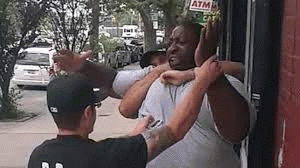Jimmy Lee Bruce, meet Eric Garner. You've got a lot in common. You're both black men from New York state. Both of you had an encounter with police officers over some comparatively minor matter. Neither of you had any weapon. You both gave the police a hard time and had what is described as a "choke hold" applied to you by an officer. You both died as a result of that use of official force.
Interestingly, those police officers had some things in common as well. They were all white. None of them was trained in the use of the choke hold, which was prohibited by their respective police forces. Also, none of them was indicted on any charges by a grand jury in connection with your deaths.
The only thing separating the two of you is time. A little more than twenty-seven years. "
Jimmy Lee Bruce died in the back of a patrol car near Middletown, N.Y., on Dec. 13, 1986. He was 20 years old. He and a group of friends from Ellenville, N.Y., had gone to a movie theater in a mall outside Middletown. The group became rowdy. There was drinking involved. Off-duty Middletown police officers, acting as security guards, escorted the group out of the theater, where a scuffle ensued. An officer applied the choke hold to Bruce and tossed him in the back of a police car, which had brought two on-duty Town of Wallkill police officers to the scene.
The police then drove around for 7 minutes looking for Bruce's friends. When they returned to the theater, a state trooper, who had also arrived on the scene, shined a flashlight in the back of the patrol car and noticed the young man was not responding to the light. Police rushed him to a nearby hospital, but attempts to revive him failed.
Two months after the incident, an Orange County grand jury began considering whether any of the officers did anything criminally wrong in connection with Bruce's death. It determined that none of the officers did anything criminally wrong because none of them had received any training in the proper application of what they, more benignly, referred to as the "sleeper hold," nor in what could result from improper use of the dangerous hold. It was an accident.
Which brings us to Eric Garner, at 43, somewhat older than Bruce and someone known to police in his Staten Island neighborhood as a familiar problem -- mostly for selling loose cigarettes on the street and getting mouthy with police who tell him to stop. On July 17 of this year, Garner, the father of six, got mouthy and maybe more with a police officer who told him to stop selling the cigarettes. The officer applied the choke hold. Garner went down. A witness taped the incident on a cell phone and caught Garner, an asthmatic, exclaiming, "I can't breathe!" A coroner ruled the death a homicide.
A Richmond County grand jury this month determined -- despite the video -- that there was no criminal wrongdoing on the part of the police officer. This ruling, coming on the heels of a similar case in Ferguson, Mo., and in the wake of a number of deaths of young black males at the hands of white police, has spurred large, public demonstrations across the country and, in fact, around the world. Justice! is the cry.
But what is justice?
For sure, it means eliminating any doubt of conflict of interest in the future by having special prosecutors, not local district attorneys, handle cases involving deaths of unarmed civilians at the hands of local police officers. This would protect police, prosecutors and the public.
But that's not nearly enough.
Shortly after Garner's death, William Bratton, New York City police commissioner, told the New York City Council that he was calling for a "fundamental shift in the culture of the department" in the wake of the chokehold killing of Garner. That "shift" will include three days of annual training for every police officer who works patrol on:






